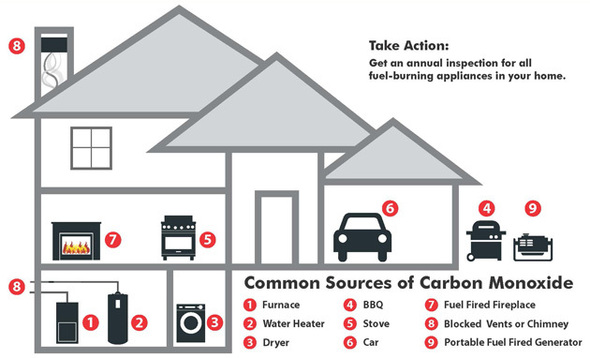Carbon Monoxide: The Silent Killer
If you think you or someone you’re with may have carbon monoxide poisoning, get to fresh air and seek emergency medical care. Call 9-1-1.
Remember, an alarm indicates elevated levels of CO in your home. Some people can be exposed to dangerous levels and not feel any symptoms. Regardless of whether or not symptoms of CO poisoning are present, never ingore the alarm!!
Symptoms
Signs and symptoms of carbon monoxide poisoning may include:
Headache
Weakness
Dizziness
Nausea or vomiting
Shortness of breath
Confusion
Blurred vision
Drowsiness
Loss of muscle control
Loss of consciousness
Safety Tips:
Install at least one battery-powered carbon monoxide alarm or AC-powered unit with battery backup on each level of your home and near sleeping areas.
Check al CO alrms in your home weekly to make sure they don’t need new batteries and they are not displaying error codes.
Replace CO alarms every 5-7 years to benefit from the latest technology upgrades in carbon monoxide detection.
Do not use charcoal or gas grills inside or operate outdoors near a window where carbon monoxide fumes could seep in.
Have a licensed professional inspect heating systems and other fuel-burning appliances annually to ensure they are functioning properly.
Have fireplaces cleaned and inspected each year for build-up residue and keep chimneys clear of animal nests, leaves, and debris for clear ventilation.
Do not block or seal shut the exhaust flues or ducts used by water heaters, ranges, and clothes dryers.
Do not leave your car running in an attached garage or carport, since vehicles release carbon monoxide when fuel is burned.
Do not use ovens or stoves to heat your home since they are both a fire hazard and CO hazard. Gas fuel appliences give off carbon monoxide, especially if they are installed incorrectly or malfunctioning.
Do not run gas-powered lawn equipment in a closed shed; instead, perform any maintenance required on equipment or tools in an area with open ventilation.
All gas powered generators should be run outside.
*Above information was obtained from
www.kidde.com
www.mayoclinic.org
www.ul.com
www.nfpa.org

Did you know…? As of January 1, 2007, homeowners, landlords, and building owners are required to install carbon monoxide (CO) detectors within 15 feet of rooms used for sleeping. This law applies only to those occupancies that use fossil fuel to cook, heat, or produce hot water, or occupancies that are connected to an enclosed garage.
Carbon monoxide alarms are a simple tool to help identify dangerous levels of the deadly gas and can save an entire family from getting hurt or even killed. If you don’t have an alarm in your home, we strongly encourage you to pick one up and install it immediately. It can save your life, and the lives of the ones you love.
Carbon monoxide is a colorless, odorless, tasteless gas produced by burning gasoline, wood, propane, charcoal or other fuel. Improperly ventilated appliances and engines, particularly in a tightly sealed or enclosed space, may allow carbon monoxide to accumulate to dangerous levels.
Carbon monoxide poisoning occurs when carbon monoxide builds up in your bloodstream. When too much carbon monoxide is in the air, your body replaces the oxygen in your red blood cells with carbon monoxide. This can lead to serious tissue damage, or even death.
How Much Carbon Monoxide is Dangerous?
Everyone is at risk for CO poisoning!. Infants, pregnant women, and people with physical conditions that limit their ability to use oxygen, such as emphysema, asthma, or heart disease, can be more severely affected by low concentrations of CO than healthy adults. High levels of CO can be fatal for anyone, causing death within minutes.
Levels of carbon monoxide exposure range from low to dangerous:
* The concentration of CO, measured in parts per million (PPM), is a determining factor in the symptoms for an average, healthy adult.
- Low level: 50 PPM and less
- Mid-level: between 51 PPM and 100 PPM
- High level: greater than 101 PPM if no one is experiencing symptoms
- Dangerous level: greater than 101 PPM if someone is experiencing symptoms
Here are some of the symptoms you can expect from carbon monoxide exposure.
- 50 PPM: None for healthy adults. According to the Occupational Safety & Health Administration (OSHA), this is the maximum allowable concentration for continuous exposure for healthy adults in any eight-hour period.
- 200 PPM: Slight headache, fatigue, dizziness, and nausea after two to three hours of exposure.
- 400 PPM: Frontal headaches with one or two hours. Life threating after three hours of exposure.
- 800 PPM: Dizziness, nausea, and convulsions within 45 minutes. Unconsciousness within two hours. Death within two to three hours.
- 1,600 PPM: Headache, dizziness and nausea within 20 minutes. Death within one hour.
For more information about your specific alarm, refer to your user’s manual.

